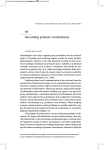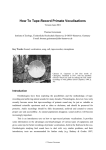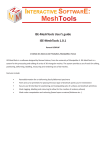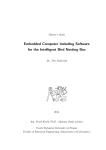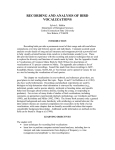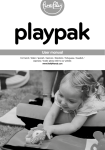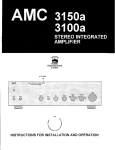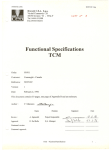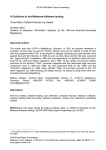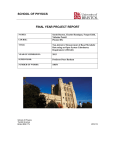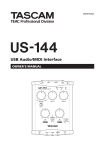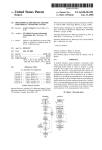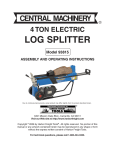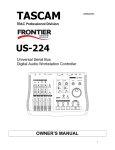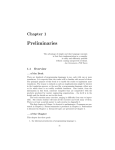Download Tape-recording primate vocalisations
Transcript
15 r Tape-recording primate vocalisations THOMAS GEISSMANN Anthropological Institute and Museum, University of Zürich, Zürich, Switzerland INTRODUCTION Ornithologists have been exploring the possibilities and methodology of taperecording and archiving animal sounds for many decades. Primatologists, however, have only recently become aware that tape-recordings of primate sound may be just as valuable as traditional scientific specimens such as skins or skeletons, and should be preserved for posterity. Audio recordings should be fully documented, archived and curated to ensure proper care and accessibility. As natural populations disappear, sound archives will become increasingly important. This article describes how to tape-record non-human primate vocalisations. It provides information on the advantages and disadvantages of various types of equipment, and gives tips for better recordings of primate vocalisations, both in the field and in the zoo. Ornithologists have to deal with very similar problems, and their introductory texts are recommended for further study (e.g. Budney & Grotke, 1997; Kroodsma et al., 1996; see also ‘Internet sites with review texts on recording nature sounds’ at the end of this chapter). Methods and equipment required for sound analysis are not included, as information on that topic has been presented elsewhere (Charif et al., 1995; Hopp et al., 1998). As a rule, prices for sound equipment go up over the years. Prices for equipment discussed below should only be used as very rough estimates. Retailers’ prices differ widely and comparing prices over the Internet before buying is recommended. SOUND RECORDERS An ideal recorder records a signal without alterations, by matching its dynamic and frequency range and preserving all its features. Traditional analogue tape-recorders, both compact cassette and reel-to-reel recorders, are not perfect. They degrade the signals they record by adding hiss, distortion, Field and Laboratory Methods in Primatology: A Practical Guide, ed. Joanna M. Setchell and c Cambridge University Deborah J. Curtis. Published by Cambridge University Press. Press 2003. 228 Tape-recording primate vocalisations 229 frequency response alterations, speed variations, print-through effects and drop-outs. Digital recorders do not have these problems. Within the dynamic range and the frequency limits (owing to the number of bits and sampling frequency they use), they record and reproduce signals with great accuracy, low noise, flat frequency response and no speed variations. Nevertheless, the quality of the signal recorded by good analogue tape-recorders is good enough for most purposes in bioacoustic studies. ANALOGUE TAPE-RECORDERS (AUDIO) Avoid the use of noise reduction features such as Dolby or DBX during recording, as they add distortion and limit the high frequencies of many sounds. If possible, use a tape-recorder with adjustable sensitivity for signal intensity. The automatic level control (ALC) found on many portable cassette recorders is often ineffective for recording sounds in the field. Unfortunately, there are very few portable machines with adjustable sensitivity. The Sony Walkman WM-D6 is small (approximately 0.64 kg, with batteries), relatively affordable (about US$ 360), and works well in rough field conditions. However, it uses bar-type metering or light emitting diodes (LEDs). The LEDs are difficult to read in bright light; in addition they are positioned on the top rather than on the side facing you as you record, making them difficult to see while recording. The mini-jack microphone connectors are the weakest part of the machine and broke repeatedly in some machines used by my students and myself. Their survival can be prolonged by avoiding lateral pressure acting on the microphone plugs while they are connected to the Walkman and by disconnecting the microphone when not using it. Despite these negative comments I have used the WM-D6 in the field for many years and can recommend it. It should be good enough for most purposes, but has no built in speaker. The heavier Sony TC-D5M and TC-D5 Pro II (approximately 1.7 kg, with batteries) exhibit more useful features. The former comes with 14 inch jack microphone connectors and costs about US$ 700, the latter has Cannon-XLR microphone connectors instead and costs US$ 1000. As I have never had problems with the 14 inch jack connectors, I prefer the cheaper of these two. Both are well designed and very durable (with metal rather than plastic housing, and a leather carrying case). They have both volume unit (VU) and peak metering; the former is an averaging system for determining recording levels, the latter is instantaneous and is important for sound recording where there may be very sudden sound level shifts that can cause overloading. These recorders come with a built-in loudspeaker, which makes it much more comfortable to check your recordings, and it can be used for simple playback experiments. However, these speakers exhibit relatively low sound pressure levels and are not recommended for serious playback experiments with primates. A single channel Sony, the TCM-5000EV (about US$ 500), is also available (also with built-in speakers) but has mini-jack connectors (see above). It also 230 T. GEISSMANN has a built-in speaker, which can be used as a playback (see above) or monitor speaker. It is intermediate in price and most features between the Walkman and the more expensive machines described above. Unfortunately, it does not allow you to use the advantages of different types of cassette (see below). Several portable cassette recorders with adjustable sensitivity are also available from Marantz (PMD-201 and 222, and CP 430). These machines offer features similar to their Sony counterparts described above, but are generally less expensive (US$ 350, US$ 420 and US$ 550, respectively). Only VU metering is provided (no LEDs). Carrying cases are not included but are available. However, the extensive use of plastics in the outer shell and the way some (plastic) function keys are exposed makes them less sturdy. The decision between stereo and mono depends on what your recording will be used for. For most field recordings, stereo is an unnecessary complication. However, if you are interested in recording vocal interactions between several individuals or groups, then a stereo machine is preferable. DIGITAL AUDIO TAPE (DAT) The DAT recording system stores sound information in a binary code, thereby making it immune to speed errors, tape noise (hiss) and non-linear frequency response problems. The frequency response of DAT recorders allows very good recordings from low frequency signals, as low as 10 Hz, up to 22 kHz. Unfortunately, they can not be used to record ultrasounds. The DAT recorder delivers a sound quality slightly better than that of a compact disc (CD) in a small, easy to use and easy to store, long duration, tape-based format. In addition, digital transfer to and from a computer allows duplication, editing and analysis in an entirely digital domain. Digital transfer from DATs to computers is possible using specific soundboards with digital input/output (I/O), which are now produced by several companies. Other features include real-time tape counters and a built-in indexing system, which allow the operator to access the starting points of the various recordings quickly. DAT recorders are more expensive than analogue tape-recorders and are available from Sony (TCD-D10 US$ 1000), Tascam (DA-P1 US$ 1500), and Fostex (PD-4 US$ 5400). Unfortunately, DATs are generally very sensitive to high humidity and are, therefore, not reliable in some recording environments such as rain forest. Most DAT recorders have a built-in ‘dew’, or humidity, sensor that shuts the machine down whenever high humidity is detected. Most DAT machines will operate for only 2 hours per battery charge, and only accept rechargeable cadmium batteries, a problem when you are working in areas with no or unreliable access to mainline power. MINIDISC (MD), DIGITAL COMPACT CASSETTE (DCC), MP3 Avoid working with technologies that remove information from the sound, such as MiniDisc, Digital Compact Cassette and Mpeg Layer 3 (MP3). There is also a forthcoming MP4 protocol as well as rival formats, such as Liquid Audio Tape-recording primate vocalisations 231 and VQF (also called TwinVQ , transform-domain weighted interleave vector quantisation). All these technologies use sound compression algorithms, discarding sound details that appear to be non-audible. For instance, MiniDisc technology incorporates input filtering and data compression strategies deliberately designed to distort the signal in subtle ways. This makes the signal more difficult to analyse and impossible for accurate frequency-related measurements. It also leads to perceptible distortion if multiple copies are made. Any such technology will change (i.e. degrade) the sound you are recording and make your recordings unsuitable for sound analysis. WHAT TO BUY – WHERE IS THE FUTURE? It is obvious from changes in the product lists of the major producers of audio equipment that both analogue audiocassette recorders and DAT are on their way out. Whereas analogue cassettes will still be around for years to come, DAT technology never built up an equally large user base and may disappear faster. Only a few good portable machines of either technology are still being sold, mainly for specialists, and prices for these machines will probably go up as the market dries up. The future is in digital media. Unfortunately, currently popular or announced technologies such as MiniDisc, MP3 or MP4 are not an option for bioacoustic analyses. Direct-to-hard-disc recording may be the option of the future, but no easily manageable and robust solution is available for long-term use in the rain forest. For the time being, at least, this author is sticking to analogue recording using audiocassettes. MICROPHONES AND PARABOLIC REFLECTORS If possible, use a directional microphone or a parabolic reflector (also called a parabola). This improves sound collection in nature considerably by attenuating unwanted ambient noise and sounds from other directions (directional microphones) or by giving emphasis to sounds coming frontally (parabolic reflectors). Directional microphones are the most useful in bioacoustic field recordings. Various names are in use for microphones with various degrees of directionality. Here, I will simply differentiate between shotgun or ultradirectional microphones and semi-directional microphones. SHOTGUN OR ULTRADIRECTIONAL MICROPHONES A shotgun microphone is a cardioid microphone fitted with an interference tube on its frontal face. It is characterised by a flat frequency response, is less sensitive to wind and handling noise but offers a lower sensitivity than a microphone mounted in a parabola. The interference tube cancels off-axis signals, while the in-axis signals reach the microphone’s diaphragm without attenuation or gain. As a rule, shotgun microphones work in mono only, so you would need two of them if you wanted to make a stereo recording. 232 T. GEISSMANN There are many brands of high quality microphones available, but they are relatively expensive. As a simple rule, the degree of directionality in shotgun microphones correlates with their length (and, usually, with their price). I have tested various models of the Sennheiser line of microphones. They are expensive but have proven to be very durable, exhibit low noise figures, and are relatively immune to high humidity. Particularly useful in the field is a combination of the ME 66 microphone capsule and the K6 pre-amp/power unit using an AA battery (about US$ 180 and US$ 215, respectively). Put together, this system has a length of 32 cm. For better directionality, you can plug the longer ME 67 (about US$ 250) onto the K6, with a combined length of 44 cm. The top-of-the-line Sennheiser shotgun microphones have particularly flat frequency curves but are more expensive (MKH 416: US$ 830, 25 cm; MKH 70: US$ 1550, 41 cm). Longer microphones are not very handy in dense tropical forests -- they get in the way and are more easily damaged than shorter microphones. Directional microphones by Audio-Technica are less expensive than the Sennheisers, and still exhibit good directionality (e.g. AT 835: US$ 330, 23 cm). They also come equipped with a windscreen. Note that you also need special microphone cables with appropriate connectors for some Sennheiser directional microphones (available separately, about US$ 30). On windy days, a rubber foam windscreen may be necessary for your directional microphone. These function to keep wind turbulence as far away from the microphone surface as possible. The cheapest option for the Sennheiser ME 66 is MZW 66. This is relatively expensive (about US$ 30), although it is basically just a tight fitting glove of rubber foam for your microphone. A similar windscreen of your own manufacture should work reasonably well and costs almost nothing. SEMI-DIRECTIONAL MICROPHONES Semi-directional microphones produced for video cameras are less directional than the shotgun microphones, but they are cheaper and smaller. They may suffice if you are tape-recording ‘loud-calls’ of primates or if you are studying captive animals, where background noise is frequently less of a problem and where the microphone can usually be positioned closer to the vocalising animals. However, the degree of directionality and other quality characteristics vary strongly (Wölfel & Schoppmann, 1994). In order to tape-record gibbon (Hylobatidae) songs, leaf monkey (Presbytini) loud calls and macaque (Macaca spp.) vocalisations in the field, I have used the following microphones with good results: JVC MZ-707, and Sennheiser MKE 300 (both below US$ 200). Furthermore, these video-microphones can be plugged directly into the Sony WM-D6C, with no special connecting cable needed (unlike some of the directional microphones from Sennheiser), but I recommend buying a cheap elongation cable (1.5 m, US$ 6). The microphone should never be too close to Tape-recording primate vocalisations 233 the cassette recorder while recording; otherwise you might have the noise of the machine on your tape-recordings. Be careful to select a microphone with a frequency range suitable for your needs. The frequency range of some of the cheaper video-microphones does not exceed 10 kHz, which makes them less suited to tape-recording primates with high pitched vocalisations (e.g. callitrichids). PARABOLIC REFLECTORS A parabola focuses incoming sound waves that are parallel to its axis onto a single point, the focus, where a microphone is placed. Whereas a shotgun microphone simply screens off sound from directions other than the sound source, a parabolic reflector can actually amplify the sound from the target direction. In addition, it also acts as a high pass filter, especially for low frequency environmental sounds. The effectiveness is determined by the diameter of the reflector in relation to the wavelength of the sound. Gain and directivity increase proportionally as the diameter : wavelength ratio increases. For wavelengths larger than the diameter of the parabola, the response is predominantly that of the microphone itself. As the wavelengths become smaller than the parabola diameter, gain and directivity increase with the frequency. Common diameters are 45 cm, 60 cm and 90 cm, with directionality starting at about 750, 550 and 375 Hz, respectively. Only the larger dishes can be recommended for primate studies: they are able to cover the frequency range of calls produced by the smaller primate species, at least. Many larger species, however, produce calls that go well below 375 Hz. It is obvious that the size of a parabolic reflector makes it difficult to use in tropical forests, even if some plastic parabola (Telinga) can be rolled up for travelling. Parabola may be of better use in stationary recording sites or in more open forests and in open habitat. There are a variety of parabolas available made of metal, fibreglass or clear plastic. Microphones for use in parabolic reflectors typically cost anywhere between US$ 300 and 1500. Some manufacturers, such as Telinga and Saul Mineroff Electronics, sell complete systems that include a parabolic reflector with a microphone and shock-mount system. If you are working on a tight budget, you might consider building a parabolic reflector yourself. With a large bowl- or umbrella-shaped dish, you can add some directionality to any non-directional microphone. The microphone is positioned in the focal point of the reflector, which, fortunately, is not very narrowly defined. The sound is concentrated in this area, and increases sensitivity. OTHER EQUIPMENT Many ornithologists recommend the use of good-quality headphones that allow you to listen while recording, making it easier to aim the microphone, 234 T. GEISSMANN as well as giving a clear idea of the quality of the recording being made. I find it inconvenient, however, to monitor the vocal activities of primates, often calling from several directions at the same time, with earphones on. I recommend using quality audio-cassettes (e.g. TDK, Maxell). Much cheaper cassettes are available, but they may yield fuzzy recordings and some frequency levels may be underrepresented. Of the available cassettes (types I, II and IV), type II tape offers the best high frequency response and the lowest signal-to-noise ratio. Interesting vocalisations tend to occur exactly when the cassette is full, and you will miss them while swapping cassettes. I therefore prefer cassettes that allow you to record for 90 or 100 minutes (instead of 60 minutes). Shorter tapes, on the other hand, are more time accurate, because the tape is thicker. Always carry a set of new, non-rechargeable batteries with you, for emergencies. Your animals often decide to vocalise after you have spent hours tape-recording background noise, and all your rechargeable batteries have expired. In such cases, an emergency set of batteries will come in handy. ULTRASOUND A number of small primates (e.g. Cebuella, Galago, Microcebus, Nycticebus) have been shown to emit ultrasound vocalisations above 20 kHz (Pariente, 1974; Pola & Snowdon, 1975; Glatston, 1979; Zimmermann, 1981; Cherry et al., 1987; Zietemann, 2000). The fundamental frequencies of some note types of Microcebus murinus reached maximum values of about 45 kHz (Zietemann, 2000). Because detecting, recording and analysing ultrasound vocalisations requires special equipment, such calls may be more widespread among small primates (and other small mammals) than has been documented so far. Fortunately, much research is being carried out on ultrasound calls of bats, and scientists wishing to study ultrasound vocalisations of primates can benefit greatly from exploring the expertise of, and the technologies being used by, bat researchers. BAT DETECTORS Bat detectors or ultrasound detectors were developed to provide researchers with instruments to study bat echolocation, but are also used for research on other small mammals and grasshoppers. Bat detectors are based on both analogue and digital techniques to detect and record ultrasounds and transform them into audible sounds. The detectors available on the market use three main systems: heterodyne frequency shifting, frequency division and time expansion. Heterodyne detectors and frequency division (or count-down) detectors are real time methods (i.e. you hear the sound from the detector at the same Tape-recording primate vocalisations 235 time as it is emitted by the bat). They are useful for quick yes/no statements of bat activity. They allow the recording of an audible representation of an ultrasonic call, not of the full ultrasonic signal structure. If you want to study the frequency spectrograms, you will need a time expansion detector (Petterson D980: US$ 3500; Ultra Sound Advice: U30 + PUSP: US$ 2867). The method is similar to making a high speed tape-recording of the sound and then playing it back at a lower speed. The ultrasonic signal is sampled at high speed, and then replayed at a lower sample rate, for example one tenth, to be made audible, and stored in this format on a tape-recorder. If the signal is stored at a sample rate 10 times lower than the original, frequencies are reduced by 10 while time is expanded by the same factor. Clearly this is not a real time conversion method, but it does offer a number of benefits over and above these methods. Since the signal is stretched out in time, it is possible to hear details of the sound not audible with other types of detector (e.g. you can actually hear frequency differences in single short pulses). Time expansion preserves all characteristics of the original signal, making time-expanded signals ideal for sound analysis in the laboratory. DIGITAL DATA ACQUISITION A second method of preserving all characteristics of the original signal involves recording the ultrasound directly into the memory of a computer-based digital signal acquisition system with fast, high capacity data storage. Modern laptop computers allow for direct high speed sampling of ultrasonic signals using a separate data acquisition card. With this method, the signal is available for immediate sound analysis, and the sound quality is usually better than in analogue recordings. In modern systems, several seconds of sampled sound are stored in a circularly addressed memory (‘circular buffer’). The maximum duration of the stored sound depends on the available memory and the selected sampling rate. The advantage of this system is that you can decide post hoc whether you want to keep the current section of your random access memory (RAM) or whether you want to continue sampling. With this convenient method, the recorded sound is constantly being deleted and memory freed while you monitor the sound activity of your study animals, until you register some interesting vocal signals. No time expansion is required with this method. You need a bat detector with high frequency output (Petterson D980: US$ 3500; Ultra Sound Advice: U30 without PUSP: US$ 668). Unlike the Petterson equipment, the bat detector (U30) and time expansion (PUSP) unit are separate units in the Ultra Sound Advice system. Because you need only the bat detector for digital data acquisition, the Ultra Sound Advice solution is cheaper. 236 T. GEISSMANN The bat detector should be connected to a high-speed A/D board in a laptop computer equipped with a large RAM and specialised software (e.g. Batsound Pro, 128 MB recommended). A complete solution (without the laptop) is available from Pettersson Elektronik AB (Sweden) for about US$ 6000. Obviously, ultrasound equipment is more expensive than that required to record audible sound and also less suitable for fieldwork in tropical forests. Of the two recording techniques described above, time expansion recording on audiotape is more robust in humid tropical environments than the laptopbased system. RECORDING PROCEDURE Get into the habit of making frequent comments on tape while recording your animals. This will be very helpful later when you analyse your recordings. For instance, if several individuals are vocalising together, it is often impossible to determine who made which vocalisation later on. It is often important to record information about the identity, sex and age of a vocalising animal, and the context in which each vocalisation is produced. It is usually impossible to describe a long vocalisation bout in detail from memory after the recording has been made. Therefore, do it as the vocal bout goes on but try to speak during intervals between vocalisations. Of course, it is best not to voice input at the same time as your target animal is calling. Always narrate ‘stop’ or some other indication that the recorder is turned off before stopping. The lack of critical voiced information on tape, especially where one recording ends and another begins, is one of the greatest failings of the beginner. If you interrupt a tape-recording (‘cut’), say so on the tape. Otherwise, it is often difficult to detect that the recorder was paused and confusion can occur during later analysis. If you continue recording the same or new target subjects following the cut, add some narration to say so. Make long, uninterrupted recordings. Vocalisations tend to occur when you think they won’t. If you are waiting for a vocalisation to occur, it may be worthwhile recording continuously, even while your animals are not vocalising. By doing so, you will catch complete vocalisations or vocal bouts, of which you would otherwise miss the beginning. If no vocalisations occur, rewind your cassette from time to time. If you already have vocalisations on the same side of the cassette on which you intend to record, set the rotationcounter to zero before starting to record again. This will allow you to rewind to the end of your last recording when you have been tape-recording for some time with no vocalisations. Hold the microphone very firmly and steadily. Even moving your fingers may interfere with recordings. Record from as close to the subject as possible. Directional microphones and parabolic reflectors are no substitute for proximity. Very soft, quiet Tape-recording primate vocalisations 237 vocalisations are lost in ambient noise if you are far away from the animal. Occasionally, closer may not be better. If you encounter a loud sound source, such as calling cicadas, somewhere between you and your target animals, going closer would bring you closer to the cicadas as well. In this case, it may be better to change position. When the side of an audio-cassette is filled with recordings, always break out the record-enabling chip on the upper left, thin side of the cassette, thus making sure that you will not accidentally record on this side again and delete important material. You may decide to give provisional field numbers to your tapes and give them final inventory numbers when you are back in the laboratory. In any case, it is important that tapes can be identified at any time and referred to in your field notes. Try to be consistent in your methods and the way that you record data. That way, someone else listening to your recordings later can learn your pattern, in your absence, and retrieve important information. Recordists frequently overlook the importance of adequate documentation of recordings, often obtained with painstaking effort and sometimes at great expense. Lack of documentation seriously weakens the scientific value of your sound recordings. After the recording has been made, the following information should be narrated on tape: 1. Recordist and equipment configuration: name of the recordist, type of recorder, microphone and parabolic reflector. 2. Identification of target subject and the degree of certainty: name of species, type of contact (heard only, seen), number of target subjects on record, sex and age class of target animal(s) or group composition (if known), approximate distance of subject from microphone, cross-references if same individual can be heard on previous recordings. 3. Time and location: date; time at the beginning and the end of recording, time at important occasions (swapping cassettes, calls of new individuals, etc.), location (accurate locality, district, province, country). 4. Other information: type of habitat, weather conditions, behaviour of subject, identification of other sounds in the background. Try to make a written edit of your tape as soon as possible after recordings are completed. Keep a journal of your recordings detailing the contents of your tapes. You can also add information that was not narrated onto the tape. Editing tape-recordings takes a lot of time but makes your collection much more usable. It is a good idea, while the day’s work is still fresh in your memory, to listen to your tape(s), and make a written record of what you have recorded. Keep your personal collection of wildlife sounds well documented and in one place. Clearly label both your tapes and the storage box. 238 T. GEISSMANN ACKNOWLEDGEMENTS I am grateful to Dr Deborah J. Curtis, Dr Sabine Schmidt, Robert Dallmann and Marina Davila Ross for reading and commenting on earlier versions of this manuscript. REFERENCES Budney, G. F. & Grotke, R. W. (1997). Techniques for audio recording vocalizations of tropical birds. Ornithol. Monogr. no. 48. Charif, R. A., Mitchell S. & Clark, C. W. (1995). Canary 1.2 User’s Manual. Ithaca, NY: Cornell Laboratory of Ornithology. Cherry, J. A., Izard, M. K. & Simons, E. (1987). Description of ultrasonic vocalizations of the mouse lemur (Microcebus murinus) and the fat-tailed dwarf lemur (Cheirogaleus medius). Am. J. Primatol. 13, 181--5. Glatston, A. R. (1979). Reproduction and behaviour of the lesser mouse lemur (Microcebus murinus, Miller 1777) in captivity. Ph.D. thesis, University College London. Hopp, S. L., Owren, M. J. & Evans, C. S. (eds.) (1998). Animal Acoustic Communication -- Sound Analysis and Research Methods. Berlin: Springer-Verlag. Kroodsma, D. E., Budney, G. F., Grotke, R. W., Vielliard, J. M. E., Gaunt, S. L. L., Ranft, R. & Veprintseva, O. D. (1996). Natural sound archives: guidance for recordists and a request for cooperation. In Ecology and Evolution of Acoustic Communication in Birds, ed. D. E. Kroodsma & E. H. Miller, pp. 474--86. Ithaca, NY: Cornell University Press. Pariente, G. F. (1974). Importance respective du réperage visuel et auditif (absence d’écholocation) chez Microcebus murinus. Mammalia 38, 1--6. Pola, Y. V. & Snowdon, C. T. (1975). The vocalizations of pygmy marmosets (Cebuella pygmaea). Anim. Behav. 23, 825--42. Wölfel, M. & Schoppmann, J. (1994). Vergleichstest: Richtmikrophone -- Lasst Mikros sprechen. VIDEOaktiv 8, 4--7. Zietemann, V. (2000). Artdiversität bei Mausmakis: Die Bedeutung der akustischen Kommunikation. Ph.D. thesis, Institut für Zoologie, Tierärztliche Hochschule Hannover. Zimmermann, E. (1981). First record of ultrasound in two prosimian species. Naturwissenschaften 68, 531. Internet sites with review texts on recording nature sounds <blb.biosci.ohio-state.edu/>. <eebweb.arizona.edu/faculty/hopp/sound.html>. <www.birds.cornell.edu/LNS/>. <www.unipv.it/cibra/>.











